Indianapolis, Indiana, Hgh State Clinic, Hgh Injections, Hrt Doctors
Indianapolis, Indiana Blood Testing Facilities
 Represents a LabCorp blood testing facility
Represents a LabCorp blood testing facility Represents a Quest Diagnostics blood testing facility
Represents a Quest Diagnostics blood testing facility

Nearby Labcorp Blood Testing facilities:
- Labcorp Center Distance: 7 m, 6620 Parkdale Pl Ste P, Indianapolis, Marion County, IN, 46254
- Labcorp Center Distance: 9 m, 7855 S. Emerson Ste R, Indianapolis, Marion County, IN, 46237
- Labcorp Center Distance: 10 m, 7914 N Shadeland Suite 150, Indianapolis, Marion County, IN, 46250
- Labcorp Center Distance: 13 m, 277 E Carmel Dr, Carmel, Hamilton County, IN, 46032
- Labcorp Center Distance: 26 m, 2605 N Lebanon St, Lebanon, Boone County, IN, 46052
- Labcorp Center Distance: 35 m, 1000 S Main St, Tipton, Tipton County, IN, 46072
- Labcorp Center Distance: 42 m, 2200 Forest Ridge Pkwy Ste 310, New Castle, Henry County, IN, 47362
- Labcorp Center Distance: 43 m, 1007 N 16Th St, New Castle, Henry County, IN, 47362
- Labcorp Center Distance: 44 m, 1000 N 16Th St, New Castle, Henry County, IN, 47362
- Labcorp Center Distance: 46 m, 3803 Southland Ave, Kokomo, Howard County, IN, 46902
- Labcorp Center Distance: 48 m, 800 S Tillotson, Muncie, Delaware County, IN, 47304
- Labcorp Center Distance: 55 m, 3554 Promenade Parkway Suite C, Lafayette, Tippecanoe County, IN, 47909
- Labcorp Center Distance: 60 m, 315 Lankford St, Clay City, Clay County, IN, 47841
- Labcorp Center Distance: 61 m, 1127 N Western Ave, Marion, Grant County, IN, 46952
- Labcorp Center Distance: 66 m, 4001 E Wabash Ave, Terre Haute, Vigo County, IN, 47803
- Labcorp Center Distance: 69 m, 1530 North 7Th Street Ste 100, Terre Haute, Vigo County, IN, 47807
- Labcorp Center Distance: 70 m, 601 Surgery Center Dr, Terre Haute, Vigo County, IN, 47802
- Labcorp Center Distance: 85 m, 408 North 2Nd St, Marshall, Clark County, IL, 62441
- Labcorp Center Distance: 87 m, 903 Nw Washington Blvd Ste C, Hamilton, Butler County, OH, 45013
- Labcorp Center Distance: 90 m, 780 Nilles Rd B, Fairfield, Butler County, OH, 45014
- Labcorp Center Distance: 92 m, 4767 N Bend Rd, Cincinnati, Hamilton County, OH, 45211
- Labcorp Center Distance: 95 m, 1036 S. Verity Pkwy, Middletown, Butler County, OH, 45044
- Labcorp Center Distance: 97 m, 955 High St, Decatur, Adams County, IN, 46733
- Labcorp Center Distance: 99 m, 10475 Reading Rd Ste 306, Evandale, Hamilton County, OH, 45241
Nearby Quest Blood Testing facilities:
- Quest Center Distance: 6 m, 2040 N Shadeland Ave, Indianapolis, Marion County, IN, 46219-1711
- Quest Center Distance: 7 m, 3850 Shore Dr Ste 101, Indianapolis, Marion County, IN, 46254-2609
- Quest Center Distance: 9 m, 8071 Township Line Rd, Indianapolis, Marion County, IN, 46260-2601
- Quest Center Distance: 11 m, 8435 Clearvista Pl, Indianapolis, Marion County, IN, 46256-3741
- Quest Center Distance: 18 m, 9669 146Th Street, Noblesville, Hamilton County, IN, 46060-5005
- Quest Center Distance: 67 m, 816 Dillon Drive, Richmond, Wayne County, IN, 47374-1911
- Quest Center Distance: 86 m, 1426 Main St, Hamilton, Butler County, OH, 45013-1004
- Quest Center Distance: 90 m, 5130 Pleasant Ave, Fairfield, Butler County, OH, 45014-2611
- Quest Center Distance: 92 m, 2475 W Galbraith Rd, Cincinnati, Hamilton County, OH, 45239-4369
- Quest Center Distance: 97 m, 62 N Breiel Blvd, Middletown, Butler County, OH, 45042-3804
- Quest Center Distance: 99 m, 5 W Wenger Rd, Englewood, Montgomery County, OH, 45322-2723
Indianapolis Hormone Replacement Therapy Services
At the Conscious Evolution Institute, we understand how important Hormone Balance is to achieving optimal health and wellness. Our clinic is licensed and board certified to perform Hormone Restoration and Optimization, and we offer a wide variety of Hormone Treatments designed to help you look and feel your best in an effort to improve your longevity and your quality of life.
We are certified to perform our services all throughout the Indianapolis metropolitan area, as well as the entire state of Indiana. If you've ever considered Hormone Replacement as an option to improve your life and your health, our friendly medical specialists can explain the whole process with you in detail and set you up with an appointment with a local affiliate in the Indianapolis area.
Indianapolis Low-T Treatments for Andropause and Testosterone Deficiency
As men grow older, the odds of experiencing sexual and health issues related to declining Testosterone Production increases every year. Testosterone Replacement Therapy is an option for patients looking to avoid the pitfalls associated with Low-T in an effort to retain sexual potency and safeguard health with regard to Testosterone Decline. Testosterone Deficiency afflicts millions of males across the country, affecting their ability to live their lives as well as their sexual and physical prowess.
If you have been experiencing sexual issues related to Testosterone Deficiency, we strongly advise you to call a medical professional like those at the Conscious Evolution Institute. We have all the training and know-how to help you discover whether your symptoms are the result of Low Levels of Testosterone, and if you qualify for Low-T Andropause Treatments, we can provide you with high quality Testosterone Products such as Testosterone Gels and Testosterone Patches which can boost your Testosterone Levels back to normal. We also offer Testosterone Injection Therapy.
Indianapolis Human Growth Hormone Replacement Therapy for Hypopituitarism and HGH Deficiency
Most people are aware of the issues associated with Testosterone Deficiency, but Human Growth Hormone Deficiency is another medical disorder that can have significant health consequences for patients. Human Growth Hormone modulates cellular metabolism, meaning that it increases the rate at which cells through the body operate, improving the ability of the body to function at its physiological peak. HGH levels are very high during adolescence, and then taper off to levels conducive to maintaining normal function in the late teens and early twenties.
Then...HGH Levels start to decline, at a rate of about 1-2 percent per year. As Human Growth Hormone Levels Decline, people start to experience significant changes in health and wellness as those levels drop, including issues with healing, poor sleep, increased illness, loss of muscle mass, fatigue, weight gain, depression, and even cognitive decline. With HGH Injection Therapy, it is possible to mitigate the effects of HGH Deficiency by restoring more natural and youthful Growth Hormone Levels. Let us check your Hormone Balance and find out if you need HGH Therapy!
Indianapolis Sermorelin Therapy for HGH Restoration and HGH Deficiency
There are other options available for patients that suffer from Human Growth Hormone Deficiency, however: The Conscious Evolution Institute also offers Sermorelin Acetate Injection Treatments which can naturally enhance the body's own ability to produce Human Growth Hormone, ensuring that the body produces exactly as much of the hormone as it needs. Injectable Sermorelin Therapy is growing in popularity for a number of reasons, and we are proud providers of this revolutionary Hormone Treatment. Many patients and their doctors prefer Sermorelin to traditional HGH Therapy.
Sermorelin is more effective at providing at providing Human Growth Hormone in a natural way that follows the body's circadian rhythm, whereas HGH Injections are metabolised quickly after a single injection. Futhermore, Sermorelin is a more cost-effective HRT Option than Bio-Identical HGH, and it can also be prescribed off-label. This means that even if you don't qualify for Growth Hormone Injections, you may still be able to benefit from Sermorelin. Just give us a call to find out more!
Indianapolis HCG Injections for Diet and Weight Loss
Not all Hormone Therapies are designed explicitly for the purpose of Hormone Restoration. Some forms of HRT Treatment can help you recalibrate your body in order to reach a new and healthier normal. HCG Weight Loss Treatments are a Bio-Identical Hormone Therapy which is designed to rapidly encourage weight loss and help patients reach a healthy weight in a matter of weeks or months. With our certified HCG Diet Regimen, it is possible to lose as much as thirty pounds in a month with a combination of HRT Therapy and a specialized low calorie diet.
HCG Therapy is unique because it stimulates healthy weight loss by promoting the burning of fat while sustaining muscle mass. It does all this while limiting the feelings of hunger associated with similar diets! Fill out the form on this page to set up a free consultation!
Indianapolis Information
Indianapolis is located in the heart of Indiana, and is also the largest city in the state as well as its capital. Indianapolis goes by many nicknames, including The Racing Capital of the World, the Crossroads of America, the Circle City, and simply, Indy. Indianapolis is a huge motorsports town, and the metro area is home of both the Indy Grand Prix, as well as the Brickyard 400 and the Indianapolis 500, all held at the Indianapolis Motor Speedway.
The city of Indianapolis has a strong economy and there are many well-known corporations based out of Indianapolis, including Rolls Royce, Finish Line, Well Point, and Eli Lilly. Indianapolis also has a well-appreciated and busy downtown, full of arts and entertainment destinations. Things to see and do in Indianapolis include the Kurt Vonnegut Memorial Library, the NCAA Hall of Champions, and the Indianapolis Museum of Art. In addition to Indianapolis' importance as a motorsports destination, the city is also known for its professional sports teams, the Indianapolis Pacers and the Indianapolis Colts.
Indianapolis is a center for education in the state of Indiana, and among the many colleges and universities in the city are Martin University, Marian University, and Butler University. Indianapolis also heavily augments the United States' presence in international and amateur sport, and is the home base of United States Track and Field, Synchronized Swimming, Diving, and Gymnastics.
All About Indianapolis, Indiana Geographic Area
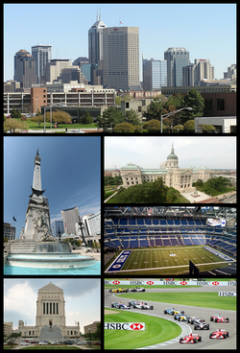
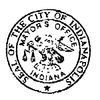
Indianapolis  /ËuɪndiÉoËnnR¦pɵlɨs/ (abbreviated Indy /Ënɪndi/) is the capital city of the U.S. state of Indiana, and also the county seat of Marion County, Indiana. As of the 2010 census, the city's population is 829,718. It is the twelfth largest city in the United States, and one of the fastest growing metropolitan areas in the United States.
/ËuɪndiÉoËnnR¦pɵlɨs/ (abbreviated Indy /Ënɪndi/) is the capital city of the U.S. state of Indiana, and also the county seat of Marion County, Indiana. As of the 2010 census, the city's population is 829,718. It is the twelfth largest city in the United States, and one of the fastest growing metropolitan areas in the United States.
Historically, Indianapolis has oriented itself around government and industry, particularly manufacturing. Over the late decades of the 20th century, the city's Unigov began a long process to revitalize the downtown area. Today, Indianapolis has a much more diversified economy, contributing to the fields of education, health care, and finance. Tourism is also a vital part of the economy of Indianapolis, and the city plays host to numerous conventions and sporting events. Of these, perhaps the most well known are the annual Indianapolis 500, Brickyard 400, and NHRA U.S. Nationals. Other major sporting events include the Men's and Women's NCAA Basketball Tournaments. Indianapolis also hosted the 2012 Super Bowl, a game that featured the New York Giants defeating the New England Patriots.
Both Forbes and Livability.com rank Indianapolis as one of the best downtowns in the United States citing "more than 200 retail shops, more than 35 hotels, nearly 300 restaurants and food options, movie theaters, sports venues, museums, art galleries and parks" as attractions. Greater Indianapolis has seen moderate growth among U.S. cities. The population of the metropolitan statistical area was 1,756,241 according to the 2010 Census, making it the 34th-largest in the United States. The 2010 population of the Indianapolis combined statistical area, a larger trade area, was 2,080,782, the 23rd-largest in the country.

Native Americans who lived in the area originally included the Miami and Lenape (or Delaware) tribes, but they were displaced from the area by the early 1820s.
Indianapolis was selected as the site of the new state capital in 1820, the old state capital having been Corydon since the formation of the state of Indiana in 1816. While most American state capitals tend to be located in the central region of their respective states, Indianapolis is the closest capital to being placed in the exact center of its state. It was founded on the White River both because of this, and because of the incorrect assumption that the river would serve as a major transportation artery. However, the waterway eventually proved to be too sandy for trade. Jeremiah Sullivan, a judge of the Indiana Supreme Court, invented the name Indianapolis by joining Indiana with polis, the Greek word for city; Indianapolis literally means "Indiana City". The state commissioned Alexander Ralston to design the new capital city. Ralston was an apprentice to the French architect Pierre L'Enfant, and he helped L'Enfant plan Washington, D.C. Ralston's original plan for Indianapolis called for a city of only one square mile (3 km ²). At the center of the city sat Governor's Circle, a large circular commons, which was to be the site of the governor's mansion. Meridian and Market Streets converge at the Circle and continue north-south and east-west, respectively.The Capital moved from Corydon on January 10, 1825. The governor's mansion was eventually demolished in 1857 and in its place stands a 284-foot (87 m) tall neoclassical limestone and bronze monument, the Indiana Soldiers' and Sailors' Monument. The surrounding street is now known as Monument Circle or just "The Circle".
The city lies on the original east-west National Road. The first railroad to serve Indianapolis, the Madison and Indianapolis, began operation on October 1, 1847, and subsequent railroad connections made expansive growth possible. Indianapolis was the home of the first Union Station, or common rail passenger terminal, in the United States. By the turn of the 20th century, Indianapolis had become a large automobile manufacturer, rivaling the likes of Detroit. With roads leading out of the city in all directions, Indianapolis became a major hub of regional transport connecting to Chicago, Louisville, Cincinnati, Columbus, Detroit, Cleveland and St. Louis, befitting the capital of a state whose nickname is "The Crossroads of America." This same network of roads would allow quick and easy access to suburban areas in future years.
City population grew rapidly throughout the first half of the 20th century. While rapid suburbanization began to take place in the second half of the century, race relations deteriorated. Even so, on the night that Martin Luther King, Jr. was assassinated, Indianapolis was the only major city in which rioting did not occur. Many credit the speech by Robert F. Kennedy, who was in town campaigning for President that night, for helping to calm the tensions. Racial tensions heightened in 1970 with the passage of Unigov, which further isolated the middle class from Indianapolis's growing African American community. Although Indianapolis and the state of Indiana abolished segregated schools just prior to Brown vs. Board of Education, the later action of court-ordered school desegregation busing by Judge S. Hugh Dillin was a controversial change.
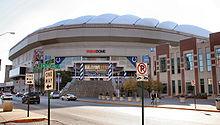
In 1970, non-Hispanic whites were about 80% of the population. In the 1970s and 1980s, Indianapolis suffered at the hands of urban decay and white flight. Major revitalization of the city's blighted areas, such as Fall Creek Place, and especially the downtown, began in the 1990s and led to an acceleration of growth on the fringes of the metropolitan area. The opening of Circle Centre in downtown Indianapolis jump started a major revitalization of the central business district. The city hosted the 1987 Pan American Games.
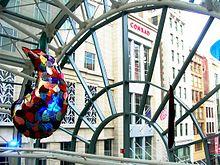
The 1970s and 1980s ushered in a period of planning and revitalization for the urban core of Indianapolis. Changes came early with the reorientation of the city aos government. Unigov was created as the result of a 1970 consolidation between city and county government. The city of Indianapolis merged most government services with those of Marion County. For the most part, this resulted in a unification of Indianapolis with its immediate suburbs. This caused the boundaries of the city to grow tremendously and would be reflected in Indianapolis ao jump to the rank of America aos 11th largest city in 1970. The City-County Building housed the newly consolidated government. At its completion, the City-County Building became the city aos tallest building and the first building in the city to be taller than the Soldiers' and Sailors' Monument. Amidst the changes in government and growth, the city aos role as a major transportation hub and tourist destination was further strengthened with the Weir Cook Municipal Airport receiving its international designation in 1975.
The city and state have invested heavily in improvement projects such as an expansion to the Convention Center, upgrading of the I-465 beltway, and construction of an entirely new airport terminal for the Indianapolis International Airport, which is now open. Construction of the Indianapolis Colts' new home, Lucas Oil Stadium, was completed in August 2008, and the hotel and convention center expansion were completed in early 2011.
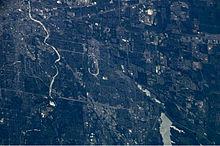
According to the United States Census Bureau, the balance (the part of Marion County not part of another municipality) has a total area of 368.2 square miles (954 km2) ae 361.5 square miles (936 km2) of it is land and 6.7 square miles (17 km2) of it is water. The total area is 1.81% water. These figures do not, however, represent the entire Consolidated City of Indianapolis (all of Marion County, except the four excluded communities). The total area of the Consolidated City of Indianapolis, not including the four excluded communities, covers approximately 373.1 square miles (966 km2).
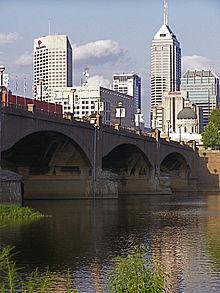
At the center of Indianapolis is the Mile Square, bounded by four appropriately named streets: East, West, North, and South Streets. Nearly all of the streets in the Mile Square are named after U.S. states. The exceptions are Meridian Street, which numerically divides west from east; Market Street, which intersects Meridian Street at Monument Circle; Capitol and Senate Avenues, where many of the Indiana state government buildings are located; and Washington Street, which was named after President George Washington. The street-numbering system centers not on the Circle, but rather one block to the south, where Meridian Street intersects Washington Street (part of the historic National Road).
Indianapolis is situated in the Central Till Plains region of the United States. Two natural waterways dissect the city: the White River and Fall Creek.
Physically, Indianapolis is similar to many other Midwestern cities. A mix of deciduous forests and prairie covered much of what is considered Indianapolis prior to the 19th century. Land within the city limits varies from flat to gently sloping; most of the changes in elevation are so gradual that they go unnoticed and appear to be flat at close range. The mean elevation for Indianapolis is 717 feet (219 m). The highest point in Indianapolis lies on the northeast side of the city. It was previously assumed that the highest point was Crown Hill Cemetery (the tomb of famed Hoosier writer James Whitcomb Riley) with an elevation of 842 feet (257 m). The lowest point in Indianapolis lies at the Marion County/Johnson County line, with an elevation of about 680 feet (207 m). The highest hill in Indianapolis is Mann Hill, a bluff located along the White River in Southwestway Park that rises about 150 feet (46 m) above the surrounding land. Variations in elevation from 700 ae900 feet occur throughout the city limits. There are a few moderately sized bluffs and valleys in the city, particularly along the shores of the White River, Fall Creek, Geist Reservoir, and Eagle Creek Reservoir, and especially on the city's northeast and northwest sides.
Indianapolis has a humid continental climate (Koppen climate classification Dfa). Like most cities in the Midwest, it has four distinct seasons. Summers are hot and humid, with high temperatures regularly approaching 90 °F (32 °C), with some days exceeding 95 °F (35 °C). Spring and autumn are usually pleasant, with temperatures reaching around 65 °F (18 °C). Spring, however, is much less predictable than autumn; midday temperature drops exceeding 30 °F (16.7 °C)) are common during March and April, and instances of very warm days (86 °F/30 °C) followed within 36 hours by snowfall are not unheard of during these months. Winters are quite cold, with an average January temperature of 28.15 °F ( na2 °C). Temperatures occasionally dip below 0 °F ( na18 °C) on 7 nights per year. The rainiest months are in the spring and summer, with average rainfall of over four inches (100 mm) per month, mostly derived from thunderstorm activity; there is no distinct dry season with slightly higher summer averages.
The city's average annual precipitation is 41 inches (1,040 mm).
The mean July temperature is 75.4 °F (24.1 °C), and the corresponding figure for January is 28.15 °F ( na2.1 °C). The record high for Indianapolis is 106 °F (41 °C), on July 25, 1954. The record low is na27 °F ( na33 °C), on January 19, 1994. Average annual snowfall is 27 inches (69 cm).
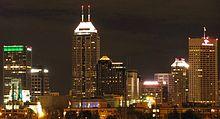

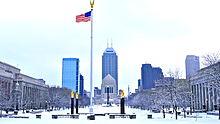
High rise construction in Indianapolis started in 1888 with the 256-foot (78 m) high Indiana Statehouse, followed by the 284-foot (87 m) Soldiers' and Sailors' Monument in 1898. However, because of a special ordinance disallowing building higher than the structure, the monument remained the highest structure until the completion of the City-County Building in 1962.
In the 1970s, the central business district, saw decreased economic activity and, as a result, downtown Indianapolis saw little new construction. By the 1980s, the city of Indianapolis addressed these issues by developing plans to redefine the city's downtown and neighborhoods. Tall skyscrapers started being built to define Indianapolis's skyline, such as the One America building in 1982. This development also carried over to the 1990s, when the Chase Tower was built.
Neighborhood development was also addressed. Indianapolis neighborhoods were designated in relation to their proximity to the city center, and plans were initiated for them to be redeveloped.
As of the 2011 Indiana Estimate, the population of Indianapolis is 839,489. The population density is 2,230 persons per square mile.
At the 2010 Census, 58.0% of the population was White, 27.2% Black or African American, 0.2% American Indian, 2.1% Asian (0.6% Chinese, 0.4% Indian, 0.3% Filipino, 0.2% Burmese, 0.2% Korean, 0.1% Vietnamese, 0.1% Japanese, 0.1% Thai, 0.1% other Asian), 0.3% from some other race (non-Hispanic) and 2.2% of two or more races (non-Hispanic). 10.0% of the population was Hispanic or Latino of any race (6.5% Mexican, 1.3% Puerto Rican, 1.1% Honduran, 1.0% Guatemalan, 0.1% other Hispanic and Latino).
Greater Indianapolis is a rapidly growing region located at the center of Indiana and consists of Marion County, Indiana and several adjacent counties. The Combined Statistical Area (CSA) of Indianapolis exceeded 2 million people in the 2007 estimate, ranking 23rd in the United States and 7th in the Midwest. As a unified labor and media market, the Indianapolis Metropolitan Statistical Area (MSA) had a 2010 population of 1.83 million people, ranking 33rd in the United States and 7th largest in the Midwest.
According to the 2006 ae2008 American Community Survey, the racial composition of the city are 66.6% White (Non-Hispanic Whites: 63.3%), 25.9% African American, 0.2% Native American or Alaska native, 1.7% Asian, 3.4% from some other race, 2.1% are from two or more races. Hispanic and Latino (of any race) make up 7.0% of the total population. Due to emigration resulting from the Yugoslav Wars in the 1990s, Indianapolis has over 10,000 people from the former Yugoslavia.
A University of Wisconsin aeMilwaukee study recently concluded that Indianapolis is the least segregated city in the northern United States, with 25% of the population living on a city block with both white and black residents.
There were 324,342 households out of which 29.8% had children under the age of 18 living with them, 40.7% were married couples living together, 15.0% had a female householder with no husband present, and 39.7% were non-families. 32.0% of all households were made up of individuals and 8.6% had someone living alone who was 65 years of age or older. The average household size was 2.39 and the average family size was 3.03.
The age distribution was 25.7% under 18, 10.1% from 18 to 24, 32.8% from 25 to 44, 20.4% from 45 to 64, and 11.1% who were 65 or older. The median age was 34 years. For every 100 females there were 93.7 males. For every 100 females age 18 and over, there were 90.1 males.
The median income for a household in the city was $40,154, and the median income for a family was $48,979. Males had a median income of $36,372 versus $27,757 for females. The per capita income for the city was $21,789. About 9.0% of families and 11.8% of the population were below the poverty line, including 16.1% of those under the age of 18 and 8.1% of those ages 65 or older.
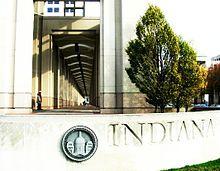
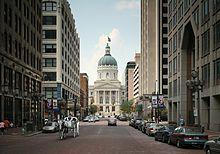
Indianapolis has a consolidated city-county government known as Unigov. Under this system, many functions of the city and county governments are consolidated, though some remain separate. The city has a mayor-council form of government.
The executive branch is headed by an elected mayor, who serves as the chief executive of both the city and Marion County. The current Mayor of Indianapolis is Republican Greg Ballard. The mayor appoints deputy mayors, city department heads and members of various boards and commissions.
The legislative body for the city and county is the City-County Council. It is made up of 29 members, 25 of whom represent districts, with the remaining four elected at large. Following the 2011 elections, Democrats hold a 16 ae13 majority over Republicans. The council passes ordinances for the city and county and also makes appointments to certain boards and commissions.
With the exception of the United States District Court for the Southern District of Indiana, all of the courts of law in Indianapolis are part of the Indiana state court system. The Marion Superior Court is the court of general jurisdiction. The 35 judges on the court hear all criminal, juvenile, probate, and traffic violation cases, as well as most civil cases. The Marion Circuit Court hears certain types of civil cases. Small claims cases are heard by Small Claims Courts in each of Marion County's nine townships. The Appeals Courts and the Indiana Supreme Court meet in the Indiana Statehouse.
The Indianapolis Fire Department provides fire protection services for six townships in Marion County (Washington, Lawrence, Center, Warren, Perry, and Franklin), plus those portions of the other three townships that were part of Indianapolis prior to the establishment of Unigov. The individual fire departments of Decatur, Pike, and Wayne townships, the town of Speedway, and the cities of Beech Grove and Lawrence, provide such services for their respective jurisdictions.
Emergency medical services (EMS) for six townships in Indianapolis (Washington, Lawrence, Center, Warren, Perry and Franklin) and the Town of Speedway are provided by Indianapolis Emergency medical services. The fire departments of Decatur, Pike and Wayne Townships, as well as the cities of Beech Grove and Lawrence, provide EMS services to their respective jurisdictions.
Indianapolis and Marion County historically maintained separate police agencies: the Indianapolis Police Department and Marion County Sheriff's Department. On January 1, 2007, a new agency, the Indianapolis Metropolitan Police Department, was formed by merging the two departments. IMPD is a separate agency, as the Sheriff's Department maintains jail and court functions. IMPD has jurisdiction over those portions of Marion County not explicitly covered by the police of an excluded city or by a legacy pre-Unigov force. As of February 29, 2008, the IMPD is headed by a Public Safety Director appointed by the Mayor of Indianapolis; the Public Safety Director appoints the Police Chief. The IMPD was formerly under the leadership of the Sheriff of Marion County, Frank J. Anderson. The Sheriff remains in charge of the County Jail and security for the City-County Building, service of warrants, and certain other functions. The Sheriff must be consulted, but does not have final say, on the appointment of the Public Safety Director and the Police Chief.
In the late 1990s, violent crimes in inner-city neighborhoods located within the old city limits (pre-consolidation) peaked. The former Indianapolis Police District (IPD), which serves about 37% of the county's total population and has a geographic area covering mostly the old pre-consolidation city limits, recorded 130 homicides in 1998 to average approximately 40.3 homicides per 100,000 people. This is over 6 times the 1998 national homicide average of 6.3 per 100,000 people. Meanwhile, the former Marion County Sheriff's Department district serving the remaining 63% of the county's population, which includes the majority of the residents in the Consolidated City, recorded only 32 homicides in 1998, averaging about 5.9 murders per 100,000 people, slightly less than the 1998 national homicide average. Homicides in the IPD police district dropped dramatically in 1999 and have remained lower through 2005. In 2005, the IPD police district recorded 88 homicides to average 27.3 homicides per 100,000 people; nonetheless, the murder rate in the IPD is still almost 5 times the 2005 national average. In 2007, city leaders such as Sheriff Frank J. Anderson and former Mayor Bart Peterson held rallies in neighborhoods in effort to stop the violence in the city.
The immediate downtown area of the city around most main attractions, venues, and museums remain relatively safe. IMPD uses horseback officers and bicycle officers to patrol the downtown area or the city. Certain areas of Indianapolis remain a challenge for law enforcement officials. Indianapolis was ranked as the 33rd most dangerous city in the United States in the 2008 ae2009 edition of CQ Press's City Crime Rankings.
Until the late 1990s, Indianapolis was considered to be one of the most conservative metropolitan areas in the country but this trend is reversing. Republicans had held the majority in the City-County Council for 36 years, and the city had a Republican mayor for 32 years from 1967 to 1999. This was in part because the creation of Unigov added several then-heavily Republican areas of Marion County to the Indianapolis city limits. More recently, Republicans have generally been stronger in the southern and western parts (Decatur, Franklin, Perry, and Wayne, townships) of the county while Democrats have been stronger in the central and northern parts (Center, Pike, and Washington townships). Republican and Democratic prevalence is split in Warren and Lawrence townships. The Indianapolis suburbs, on the other hand, remain some of the most reliably Republican areas in Indiana and the nation.
In the 1999 municipal election, Democrat Bart Peterson defeated Indiana Secretary of State Sue Anne Gilroy by 52% to 41%. Four years later, Peterson was re-elected with 63% of the vote over Marion County Treasurer Greg Jordan. Republicans narrowly lost control of the City-County Council that year. In 2004, Democrats won the Marion County offices of treasurer, surveyor and coroner for the first time since the 1970s. The county GOP lost further ground during the 2006 elections with Democrats winning the offices of county clerk, assessor, recorder and auditor. Only one GOP countywide office remained: Prosecutor Carl Brizzi, who defeated Democratic challenger Melina Kennedy with 51% of the vote in his bid for a second term, despite outspending her two-to-one. At the township level, Democrats picked up the trustee offices in Washington, Lawrence, Warren and Wayne townships, while holding on to Pike and Center townships.
In the 2007 municipal election, fueled by voter angst against increases in property and income taxes as well as a rise in crime, Republican challenger Greg Ballard narrowly defeated Peterson 51% to 47% aethe first time an incumbent Indianapolis mayor was removed from office since 1967. Discontent among these issues also returned control of the City-County Council to the GOP with a 16 ae13 majority. Ballard was re-elected mayor in 2011. Control of the city-county council reverted back to Democrats 16-13 over Republicans, marking only the second time in the Unigov era of split-party control of county government between the council and mayor.
In the 2008 presidential election, Barack Obama easily won in Indianapolis by earning 64% of all Marion County votes while 35% of the votes went to John McCain.
As 2010 came to an end, despite a strong performance by the GOP statewide, Democrats swept all county offices once again, including reclaiming the office of county prosecutor for the first time since 1990.
Most of Indianapolis is within the 7th Congressional District of Indiana, represented by Democrat Andre Carson. He is the grandson of the district's previous representative, Julia Carson who held the seat from 1997 until her death on December 15, 2007. The younger Carson, a former member of the City-County Council, won the seat in a special election on March 11, 2008. The northeastern and southeastern portions of the city are in the 5th District, represented by Republican Dan Burton. A portion of western Indianapolis is in the 4th District, represented by Republican Todd Rokita.
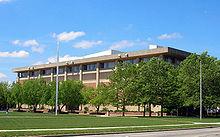
Indianapolis is the home of: Ball State University Indianapolis Center, Butler University, Indiana University-Purdue University Indianapolis (IUPUI), Ivy Tech Community College of Indiana, Marian University, Martin University, Oakland City University Indianapolis campus, The Art Institute of Indianapolis, Vincennes University Aviation Technology Center, the University of Indianapolis, the University of Phoenix, and WGU Indiana.
Butler University was originally founded in 1855 as North Western Christian University. The school purchased land in the Irvington area in 1875. The school moved again in 1928 to its current location at the edge of the Butler-Tarkington neighborhood. The school removed itself officially from religious affiliation, giving up the theological school to Christian Theological Seminary. A private institution, Butler's current student enrollment is approximately 4,400. Butler has a storied sports heritage in regards to basketball and volleyball. Butler is the site where both the film Hoosiers and the events that inspired it were filmed, the so-called Milan Miracle. Butler's basketball stadium, Hinkle Fieldhouse, was the largest basketball facility when built and also historically hosted the first bout between the U.S. and Soviet Union in basketball. Butler University made its own impact felt with a championship appearance in its home city of Indianapolis in the NCAA championship game in 2010, and a repeat appearance in the NCAA Championship game in 2011. Butler also has hosted to date the largest attended volleyball match at 14,000 spectators.
Indiana University-Purdue University Indianapolis was originally an urban conglomeration of branch campuses of the two major state universities: Indiana University in Bloomington and Purdue University in West Lafayette, created by the state legislature. In 1969 a merged campus was created at the site of the Indiana University School of Medicine. IUPUI's student body is currently just above 30,000, making it the third-largest campus for higher learning in Indiana after the main campuses of IU and Purdue. The Indiana University Robert H. McKinney School of Law is located on the IUPUI campus; the school's distinctive Inlow Hall is located on the Southeast corner of the campus. This campus is also home to Herron School of Art and Design, which was established privately in 1902. A new building was built in 2005 under both private donation and state contribution enabling the school to move from its original location. IUPUI has a division one basketball program and has made tournament appearances in the Summit League alongside Indianapolis's other division one school, Butler University. IUPUI has the only Android Studies Department in the United States.
Ivy Tech Community College of Indiana, a state funded public school, was founded as Indiana Vocational Technical College in 1963. With 23 campuses across Indiana, Ivy Tech has a total enrollment of 86,130, as of 2008, according to the school's website.
Marian University was founded in 1936 when St. Francis Normal and Immaculate Conception Junior College merged. The college moved to Indianapolis in 1937. Marian is currently a private Catholic school and has an enrollment of approximately 2,400 students.
The University of Indianapolis is a private school affiliated with the United Methodist Church. Founded in 1902 as Indiana Central University, the school's current enrollment is approximately 5,000 students. The University of Indianapolis prides itself on its teaching and nursing programs, as well as its opportunities to study abroad. UIndy has satellite campuses in Cyprus, Jerusalem, and at the base of the Acropolis in Athens, Greece. The University of Indianapolis hosted the National Football Conference practice facility for Super Bowl XLVI in 2012.
Indianapolis has eleven unified public school districts (eight township educational authorities and three legacy districts from before the unification of city and county government), each of which providing primary, secondary, and adult education services within its boundaries. The boundaries of these districts do not exactly correspond to township (or traditional) boundaries, but rather cover the areas of their townships that were outside the pre-Unigov city limits. Indianapolis Public Schools, which serves what was the city of Indianapolis prior to the Unigov merger, is still the largest school corporation in Indiana today.
Private schools run by the Archdiocese of Indianapolis are Bishop Chatard, Roncalli, Cardinal Ritter, and Scecina. Other private schools include Brebeuf Jesuit, Park Tudor, Cathedral and Heritage Christian.
Public library services are provided to the citizens of Indianapolis and Marion County by the Indianapolis-Marion County Public Library (IMCPL). The educational and cultural institution, founded in 1873, now consists of a main library, Central Library, located in downtown Indianapolis, and 22 branch locations spread throughout the city. Serving over 5.43 million visitors in 2006, IMCPL's mission is to provide "materials and programs in support of the lifelong learning, recreational and economic interests of all citizens of Marion County." The renovated Central Library building opened on December 9, 2007, ending a controversial multi-year rebuilding plan.
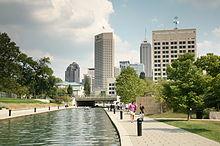
Indianapolis prides itself on its rich cultural heritage. Several initiatives have been made by the Indianapolis government in recent years to increase Indianapolis's appeal as a destination for arts and culture.
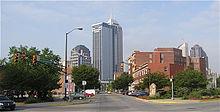
Indianapolis has designated six official Cultural Districts. They are Broad Ripple Village, Massachusetts Avenue, Fountain Square, The Wholesale District, Canal and White River State Park, and Indiana Avenue. These areas have held historic and cultural importance to the city. In recent years they have been revitalized and are becoming major centers for tourism, commerce and residential living.
Scheduled for completion at the end of 2012, the Indianapolis Cultural Trail: is an urban bike and pedestrian path that connects the city's five downtown Cultural Districts, neighborhoods and entertainment amenities, and serves as the downtown hub for the entire central Indiana greenway system. The trail includes benches, bike racks, lighting, signage and bike rentals/drop-offs along the way and also features local art work.
At the center of Indianapolis is Monument Circle, a traffic circle at the intersection of Meridian and Market Streets, featuring the Soldiers' and Sailors' Monument. Monument Circle is depicted on the city aos flag. It is in the shadow of Indiana's tallest skyscraper, the Chase Tower. Until the early 1960s, Indianapolis zoning laws stated that no building could be taller than the Soldiers and Sailors Monument. Each Christmas season, lights are strung onto the monument and lit in a ceremony known as the Circle of Lights, which attracts tens of thousands of Hoosiers to downtown Indianapolis on the day after Thanksgiving.
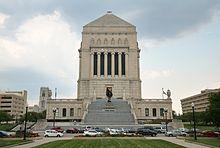
A five-block plaza at the intersection of Meridian and Vermont surrounds a large memorial dedicated to Hoosiers who have fought in American wars. It was originally constructed to honor the Indiana soldiers who died in World War I, but construction was halted due to lack of funding during the Great Depression, and it was finished in 1951. The purpose of the memorial was later altered to encompass all American wars in which Hoosiers fought.
The monument is modeled after the Mausoleum of Maussollos. At 210 feet (64 m) tall, it is approximately 75 feet taller than the original Mausoleum. On the north end of the War Memorial Plaza is the national headquarters of the American Legion and the Indianapolis-Marion County Public Library's Central Library.
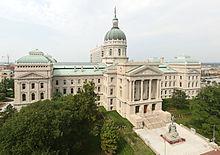
The Statehouse houses the Indiana General Assembly, the Governor of Indiana, state courts, and other state officials.
The city is second only to Washington, D.C., for the number of war monuments inside city limits.
In 2003, Indianapolis began hosting Gen Con, the largest role-playing game convention in the North America (with record attendance being over 41,000) at the Indiana Convention Center. Attendance of the event is expected to increase as the center is expanded. The convention center has also recently hosted to events such as Star Wars Celebration II and III, which brought in Star Wars fans from around the world, including George Lucas.
Indianapolis hosted Super Bowl XLVI at Lucas Oil Stadium in 2012, the first Super Bowl to be played in the city. The event attracted hundreds of thousands of visitors to the city, including celebrities such as Adam Sandler and Madonna.
Indianapolis hosted the National FFA Convention from 2006 to 2012 and will rotate with Louisville every 3 years starting in 2013. The FFA Convention draws approximately 55,000 attendees and has an estimated $30 ae$40 million direct visitor impact on the local economy. Attendees occupy 13,000 hotel rooms in 130 metro-area hotels on peak nights during the four-day convention, making it the largest convention in the history of Indianapolis.
Indianapolis has evolved into a center for music. The city plays host to Music for All, Inergy, Indy's Official Musical Ambassadors, the Percussive Arts Society, and the American Pianists Association.
As well as being the home of the Indianapolis Symphony Orchestra, Indianapolis is also home to Bands of America (BOA), a nationwide organization of high school marching, concert, and jazz bands. Indianapolis is now also the international headquarters of Drum Corps International, a professional drum and bugle corps association.
Indianapolis has been the headquarters of the Kiwanis International organization since 1982. The organization and its youth-sponsored Kiwanis Family counterparts, Circle K International and Key Club International, administer all their international business and service initiatives from Indianapolis.
Indianapolis contains the national headquarters for twenty-six fraternities and sororities, many of which are congregated in the College Park area surrounding The Pyramids.
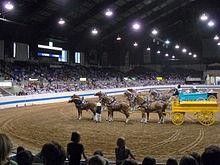
The International Violin Competition of Indianapolis, Indy Jazz Fest, and the DCI World Championships are all held in Indianapolis.
The Indianapolis Symphony Orchestra has hosted an annual outdoor summer concert series at Conner Prairie called Marsh Symphony on the Prairie since 1982, featuring a variety of musical styles.
The city has an arts community that includes many fairs celebrating a wide variety of arts and crafts. They include the Broad Ripple Art Fair[dead link], Talbot Street Art Fair, Carmel Arts Festival, Indian Market and Festival[dead link], and the Penrod Art Fair.
Every May since 1957, Indianapolis has held the 500 Festival, a month of events including a mini marathon and a festival parade, the latter being the day before the Indianapolis 500.
Indianapolis is also home to the Indiana State Fair as well as the Heartland Film Festival, the Indianapolis International Film Festival, the Indianapolis Theatre Fringe Festival, the Indianapolis Alternative Media Festival, and the Midwest Music Summit.
The Circle City Classic is one of America aos top historically African-American college football games. This annual football game, held during the first weekend of October, is the showcase event of an entire weekend. The weekend is a celebration of cultural excellence and educational achievement while showcasing the spirit, energy and tradition of America aos historically black colleges and universities.
One of the largest ethnic and cultural heritage festivals in Indianapolis is the Summer Celebration held by Indiana Black Expo. This ten-day national event highlights the contributions of African-Americans to U.S. society and culture and provides educational, entertainment, and networking opportunities to the over 300,000 participants from around the country.
During the month of June, the Indianapolis Italian Street Festival is held at Holy Rosary Church just south of downtown.
Indy's International Festival is held annually in November at the Indiana State Fairgrounds. Local ethnic groups, vendors and performers are featured alongside national and international performers.
Since 2006, in the months of March and October, Midwest Fashion Week takes place, promoting both local and national designers. Started by Berny Martin of Catou, this event has grown to become a premier event in Indianapolis.
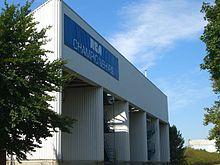
The labels of The Amateur Sports Capital of the World and The Racing Capital of the World have both been applied to Indianapolis. The headquarters of the National Collegiate Athletic Association (NCAA), the main governing body for U.S. collegiate sports, is located in Indianapolis, as is the National Federation of State High School Associations. The city is home to the headquarters of three NCAA athletics conferences, the Horizon League (Division I), the Great Lakes Valley Conference (Division II), and the Heartland Collegiate Athletic Conference (Division III). Starting in 2002, Indianapolis began hosting the Big Ten Conference Men's Basketball Tournament at Bankers Life Fieldhouse, alternating years with the United Center in Chicago. From 2008 to 2012, Indianapolis was the sole city to host the tournament. Beginning in 2013, Chicago and Indianapolis will begin alternating again. Indianapolis also hosted the 2011 Big Ten Football Championship Game. The national offices for the governing bodies of several sports are located in Indianapolis, including USA Gymnastics, USA Diving, US Synchronized Swimming, and USA Track & Field.
Indianapolis is a major automobile racing center. Since 1911 the Indianapolis 500 has been the premier event in the National Championship of open wheel car racing. The series' headquarters and many of its teams are based in the city. Indianapolis is so well connected with racing that it has inspired the name "Indy car", used both for both the competition and the type of car used in it. Indianapolis Motor Speedway hosts three major motor racing events every year: the Indianapolis 500, the Brickyard 400, and the Red Bull Indianapolis Grand Prix.
Indianapolis is home to two major league-level sports teams. The Indianapolis Colts of the National Football League (NFL) have been based in Indianapolis since relocating there in 1984, and play their home games in Lucas Oil Stadium. The Indiana Pacers of the National Basketball Association (NBA) play their home games at Bankers Life Fieldhouse; they began play in 1967 in the American Basketball Association (ABA) and joined the NBA when the leagues merged in 1976.
A number of minor league-level teams also play in the city. The Indiana Fever Women's National Basketball Association (WNBA) started play in 2000, and are under the same ownership as the Pacers NBA team. The Indianapolis Indians are the second oldest minor league baseball team, having played in the city since 1902, and are currently members of the Triple-A International League. FC Indiana of WPSL Elite League, which formed in 2000, play their home games at IU Michael A. Carroll Track & Soccer Stadium. The Indiana Ice ice hockey team began play in the United States Hockey League (USHL) in 2004.
Indianapolis hosted the Indianapolis Tennis Championships through 2009, one of the many tournaments which are part of the US Open Series. On May 20, 2008, the city was awarded the rights to host Super Bowl XLVI for which it did February 5, 2012. Indianapolis also hosted the 1987 Pan American Games and the 2002 World Basketball Championships.
On November 18, 2012, Bankers Life Fieldhouse will be hosting the 2012 WWE Survivor Series.
Other large sporting events include the Drum Corps International World Championships, and the Music for All Bands of America Grand National Championships.
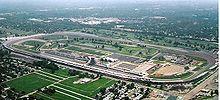
The Indianapolis Motor Speedway (IMS), located in Speedway, Indiana, is the site of the Indianapolis 500-Mile Race (also known as the Indy 500), an open aewheel automobile race held each Memorial Day weekend on a 2.5 miles (4.0 km) oval track. The Indy 500 is the largest single aeday sporting event in the world, hosting more than 257,000 permanent seats (not including the infield area). The track is often referred to as the Brickyard, because it was paved with 3.2 million bricks shortly after its construction in 1909. Today the track is paved in asphalt, although a one aeyard strip of bricks remains at the start/finish line.
IMS also hosts the NASCAR Sprint Cup Series' Brickyard 400. The first running of the Brickyard 400 was in 1994, and the race has traditionally been NASCAR's highest attended event. Jeff Gordon has frequented victory lane four times at Indianapolis, the most of any NASCAR driver.
From 2000 to 2007, IMS hosted the Formula One United States Grand Prix (USGP). Contract negotiations between IMS and Formula One resulted in a discontinuation of the USGP at Indianapolis in 2007. The USGP was not a part of the Formula One calendar from 2008 ae2011, but will be held in Austin, Texas starting in 2012.
The Speedway hosted its first MotoGP event in 2008, with the Red Bull Indianapolis Grand Prix taking place in September. Each year the event has been held, there has been a different rider in victory circle (Valentino Rossi in 2008, Jorge Lorenzo in 2009, Dani Pedrosa in 2010, and Casey Stoner in 2011).
Indianapolis is also home to Lucas Oil Raceway at Indianapolis. Though not as well known as Indianapolis Motor Speedway, Lucas Oil Raceway is home to the NHRA Mac Tool U.S. Nationals, the biggest, oldest, richest, and most prestigious drag race in the world. The event is held every Labor Day weekend.
Indianapolis is home to the largest mini-marathon (and eighth-largest running event) in America. 2007 was the 30th anniversary of the Mini, run in the first weekend in May every year. This event is part of the 500 Festival, its 50th year running. The race starts on Washington Street just off Monument Circle, goes to the brickyard, and ends on New York Street back downtown. The Mini has been sold out every year, with well over 35,000 runners participating.
Indianapolis has an extensive municipal park system with nearly 200 parks occupying over 10,000 acres (40 km2). The flagship Eagle Creek Park is the largest municipal park in the city, and ranks among the largest urban parks in the United States.
Other major Indianapolis Regional parks include:
Additionally, Indianapolis has an urban forestry program that is recognized by the National Arbor Day Foundation's Tree City USA standards.
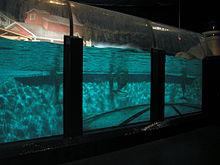
Opened in 1988, the Indianapolis Zoo is the largest zoo in the state, and is located just west of downtown in White River State Park. It has 360 species of animals, and is known for its dolphin exhibit.
Indianapolis is home to a wealth of venues for the performing arts. The following theaters offer plays, Broadway hits, comedy, musicals, concerts, and other live performances to Indy theater goers.
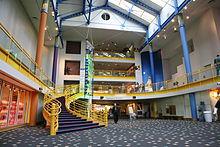
Indianapolis has a wide variety of museums and galleries which appeal to art lovers, car enthusiasts, sports fans, history buffs, and science and technology brain acts.
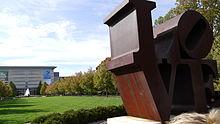
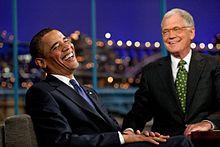
Indianapolis is served by local, regional, and national media.
National broadcast television affiliates include ABC affiliate WRTV (channel 6), CBS affiliate WISH-TV (channel 8), NBC affiliate WTHR (channel 13), Fox affiliate WXIN (channel 59), and PBS local affiliate WFYI (channel 20).
The Indianapolis Star is the city's daily newspaper.
Indianapolis is also home to the world wide headquarters of Emmis Communications, (NASDAQ: EMMS) a media conglomerate. The company owns radio stations and magazines in the United States, Hungary, Slovakia and Bulgaria.
The largest industry sectors by employment in Indianapolis are manufacturing, health care and social services, and retail trade. Compared to Indiana as a whole, the Indianapolis metropolitan area has a lower proportion of manufacturing jobs and a higher concentration of jobs in wholesale trade; administrative, support, and waste management; professional, scientific, and technical services; and transportation and warehousing.
Many of Indiana's largest and most recognized companies are headquartered in Indianapolis, including pharmaceutical manufacturer Eli Lilly and Company; wireless distribution and logistics provider Brightpoint; health insurance provider Wellpoint; retailers Marsh Supermarkets, Finish Line, and hhgregg Inc.; Republic Airways Holdings (including Chautauqua Airlines, Republic Airlines, and Shuttle America); and REIT Simon Property Group. The U.S. headquarters of Roche Diagnostics, Conseco, First Internet Bank of Indiana, Dow AgroSciences, Emmis Communications, Steak 'n Shake, and Allison Transmission are also located in Indianapolis. Other major Indianapolis area employers include Indiana University Health, Sallie Mae, Cook Group, Rolls-Royce, Delta Faucet Company, Ice Miller, Raytheon, Carrier and General Motors.
Indianapolis is a prime center for logistics and distribution facilities. It is home to a FedEx Express hub at the Indianapolis International Airport and distribution centers for companies such as Amazon.com, Foxconn, Finish Line, Inc., Fastenal, Target, and CVS Pharmacy.
Before Detroit came to dominate the American automobile industry, Indianapolis was also home to a number of carmakers, including Duesenberg, Marmon Motor Car Company, Stutz Motor Company, American Motor Car Company, Parry Auto Company, and Premier Motor Manufacturing. In addition, Indianapolis hosted auto parts companies such as Prest-O-Lite, which provided acetylene generators for brass era headlights and acetylene gas starters.
ATA Airlines (previously American Trans Air) was headquartered in Indianapolis prior to its collapse.
Forbes magazine ranked Indianapolis the sixth-best city for jobs in 2008, based on a combined graded balance of perceived median household incomes, lack of unemployment, income growth, cost of living and job growth. However, in 2008, Indiana ranked 12th nationally in total home foreclosures and Indianapolis led the state.
The National Association of Home Builders and Wells Fargo ranked Indianapolis the most affordable major housing market in the U.S. for the fourth quarter of 2009. That year, Indianapolis also ranked first on CNN/Money's list of the top ten cities for recent graduates.
In 2010, Indianapolis was rated the tenth best city for relocation by Yahoo Real Estate, and tenth among U.S. metropolitan areas for GDP growth.
In 2011, Indianapolis ranked sixth among U.S. cities as a retirement destination, as one of the best Midwestern cities for relocation, best for rental property investing, and best in a composite measure that considered local employment outlook and housing affordability.
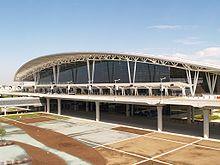
Indianapolis International Airport, airport code IND, is the largest airport in Indiana and serves the Indianapolis metropolitan area as well as many other communities in the state of Indiana.
The airport is home to the second largest FedEx operation in the world (after the Memphis headquarters) and the United States Postal Service Eagle Network Hub. The entire airport is a global free trade zone called INZONE with eighteen designated subzones.
Thirty years in planning, a new midfield terminal complex was completed in 2008. It officially opened for arriving flights on November 11, 2008 and departures on November 12, 2008. The $1.1 billion project represents the largest development initiative in the city's history. The new Indianapolis Airport covers 1,200,000 square feet (110,000 m2), and has 40 gates, a 145,000 sq ft (13,500 m2) baggage processing area, a 73,000 sq ft (6,800 m2) baggage claim area, a large pre-security gathering, a concession space with a 60-foot (18 m) skylight, numerous local and national restaurants and retailers, and local Indianapolis artwork. Indianapolis International Airport's new terminal structure was the first one built in the United States since September 11, 2001.
Ten major U.S. and international airlines serve the airport.
Interstate Highways
US Highways
Indiana Highways
Several interstates serve the Indianapolis area. Interstate 65 runs northwest to Gary, where other roads eventually take drivers to Chicago, and southward to Louisville, Kentucky. Interstate 69 runs northeast to Fort Wayne, Indiana, and currently terminates in the city at I-465, but will eventually be routed around the city on 465 to the new extension of Interstate 69 towards Evansville. Interstate 70 follows the old National Road, running east to Columbus, Ohio and southwest to St. Louis, Missouri. Interstate 74 goes northwest towards Danville, Illinois, and southeast towards Cincinnati, Ohio. Finally, Interstate 465 circles Marion County and joins the aforementioned highways together. In 2002, the interstate segment connecting Interstate 465 to Interstate 65 on the northwest side of the city was redesignated Interstate 865 to reduce confusion. The Indianapolis area also has two other expressways: Sam Jones Expressway (formerly Airport Expressway), and Shadeland Avenue Expressway.
To comply with an Indiana state law limiting the number of miles of state highways, all US and Indiana State numbered routes were rerouted along I-465 instead of going through the center of the city. At one point (between Exits 47 and 49) on the southeast side of the city, I-465, US 31, US 36, US 40, US 52, US 421, Indiana 37, and Indiana 67 use the same right-of-way. Between Exits 49 and 2 (along the south end of the city), I-74, I-465, US 31, US 36, US 40, US 52, Indiana 37 and Indiana 67 operate on the same right-of-way.

The Indianapolis Public Transportation Corporation, known locally as IndyGo, provides public transportation for the city. IndyGo was established in 1975 after the city of Indianapolis took over the city's transit system. Prior to 1997, IndyGo was called Metro. Central Indiana Commuter Services (CICS), funded by IndyGo to reduce pollution, serves Indianapolis and surrounding counties.
Starting in 2010, private industry leaders from Central Indiana proposed a $10 billion multimodal regional transportation plan that includes expanded roadways, express bus routes, light rail, and commuter rail pathways. If public and legislative approval is granted, construction could begin as soon as 2012.
Indiana University Health operates a people mover connecting the Indiana University School of Medicine, Riley Hospital for Children, Wishard Hospital and IUPUI facilities at the north end of the Downtown Canal with Methodist Hospital. It is open to the public but mostly used by doctors, staff, and patients of the various medical facilities. It is currently the only example of light or commuter rail in Indianapolis. The existing people mover is sometimes inaccurately described as a monorail, but in fact rides on dual concrete beams with the guideway as wide as the vehicle.
Amtrak, the national passenger rail system, provides service to Indianapolis at the Indianapolis Union Station. Amtrak provides a twice-weekly service of the Cardinal to Chicago, New York City, Philadelphia, and Washington, D.C. as well as the daily Hoosier State to Chicago.
Greyhound Lines operates a bus depot at Indianapolis Union Station, and Megabus has a stop adjacent to the Indianapolis City-County Building.

Indianapolis has Eight sister cities, as designated by Sister Cities International:
Word Count: 8742






